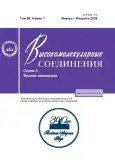ESR Investigation of the Interaction of Copper Nanoparticles Precursors with Polyethylenimine
- Authors: Motyakin M.V.1,2, Ozerin A.S.3, Ionova I.S.1, Radchenko F.S.3, Novakov I.A.3
-
Affiliations:
- Semenov Federal Research Center for Chemical Physics, Russian Academy of Sciences
- Emanuel Institute of Biochemical Physics, Russian Academy of Sciences
- Volgograd State Technical University
- Issue: Vol 65, No 1 (2023)
- Pages: 50-53
- Section: ПОЛИЭЛЕКТРОЛИТЫ
- URL: https://journals.rcsi.science/2308-1120/article/view/135336
- DOI: https://doi.org/10.31857/S2308112023700372
- EDN: https://elibrary.ru/VAIZAH
- ID: 135336
Cite item
Full Text
Abstract
The process of complex formation between polyethylenimine and copper cations in an aqueous solution, followed by isolation of copper nanoparticles, has been studied by means of ESR spectroscopy. It has been shown that in excess of the polymer in the solution the copper cation forms complex containing three nitrogen atoms in the coordination sphere, with distorted tetragonal geometry. The increase in copper concentration has led to the formation of the copper cation complex with water. Addition of the reducing agent NaBH4 to the studied solutions has led to the formation of copper nanoparticles accompanied by gradual disappearance of the ESR signal of Cu(II) and the appearance of the ESR signal typical of the mononuclear copper complexes with polyethylenimine.
About the authors
M. V. Motyakin
Semenov Federal Research Center for Chemical Physics, Russian Academy of Sciences; Emanuel Institute of Biochemical Physics, Russian Academy of Sciences
Email: asozerin@vstu.ru
119991, Moscow, Russia; 119334, Moscow, Russia
A. S. Ozerin
Volgograd State Technical University
Email: asozerin@vstu.ru
400005, Volgograd, Russia
I. S. Ionova
Semenov Federal Research Center for Chemical Physics, Russian Academy of Sciences
Email: asozerin@vstu.ru
119991, Moscow, Russia
F. S. Radchenko
Volgograd State Technical University
Email: asozerin@vstu.ru
400005, Volgograd, Russia
I. A. Novakov
Volgograd State Technical University
Author for correspondence.
Email: asozerin@vstu.ru
400005, Volgograd, Russia
References
- Semenova A., Giles L.W., Vidallon M.L.P., Follink B., Brown P.L., Tabor R.F. // Langmuir. 2022. V. 38. № 34. P. 10585.
- Kim K., Lee J.W., Shin K.S. // ACS Appl. Mater. Interfaces. 2012. V. 4. P. 5498.
- Recent Development in Bio-nanocomposites for Biomedical Applications. New York.: Nova Sci. Publ. Inc., 2010.
- Ustyakina D.R., Chevtaev A.S., Tabunshchikov A.I., Ozerin A.S., Radchenko Ph.S., Novakov I.A. // Polymer Science B. 2019. V. 61. № 3. P. 261.
- Ottaviani M.F., Bossmann S., Turro N.J., Tomaliall D.A. // J. Am. Chem. Soc. 1994. V. 116. P. 661.
- Ottaviani. M.F., Montalti F., Turro N.J., Tomalia D.A. // J. Phys. Chem. B. 1997. V. 101. P. 158.
- Carone M., Moreno S., Cangiotti M., Ottaviani M.F., Wang P., Carloni R., Appelhans D. // Langmuir. 2020. V. 36. P. 12816.
- Кабанов Н.М., Кокорин А.И., Рогачева В.Б., Зезин А.Б. // Высокомолек. соед. А. 1979. Т. 21. № 1. С. 209.
- Alonso-Amigo M.G., Schlick S. // J. Phys. Chem. 1986. V. 90. P. 6353.
- Rex G.C., Schlick S. // J. Phys. Chem. 1985. V. 89. P. 3598.
- Chiarantini L., Cerasi A., Giorgi L., Formica M., Ottaviani M.F., Cangiotti M., Fusi V. // Bioconjugate Chem. 2003. V. 14. P. 1165.
- Danilczuk M., Schlick S., Coms F.D. // Macromolecules. 2013. V. 46. № 15. P. 6110.
Supplementary files












